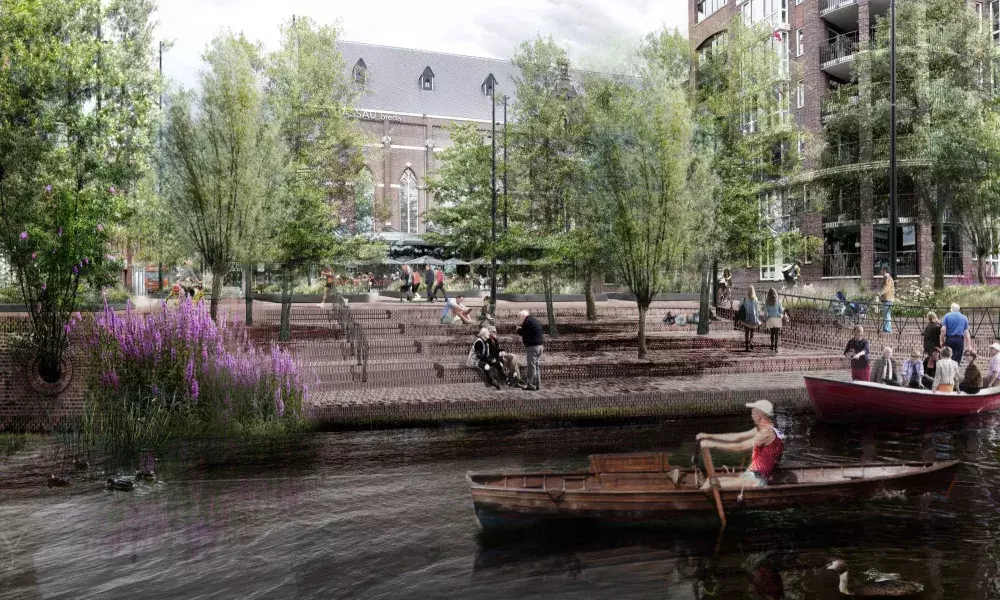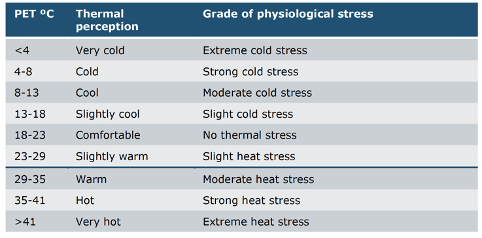
The project will enable nature to take the space despite the challenge of vertical quay walls. Greener quays have been an explicit request of Breda’s citizens. As space is scarce, these innovative nature-based solutions should serve multiple benefits, among them offering climate change adaptation. Breda, like many other cities, will face climate change impacts, in particular flooding and heatwaves. Both are further acerbated by the densely built urban centre, which also contributes to generating the urban heat island effect. Therefore, developing a climate-responsive design is also aimed for.
It sounds natural and easy to use nature-based solutions as they are commonly perceived as effective to combat urban heat. Boosting urban green areas and elements such as trees, green facades and roofs are good to adapt to climate change impacts, in particular to cool during heatwaves and to infiltrate storm water appear meaningful.
“The more, the better “– but is it as simple as this? Or are there also pitfalls, low or even adverse effects?
How can nature-inclusive quays also deliver effective climate adaptation?
João Cortesão and his colleagues from Wageningen University & Research (WUR) are project partners and responsible to advise the design team at Breda municipality on ensuring that the quays can not only serve nature but provide relief from heat on hot days and during heatwaves as well. The issue of flooding and water management is mainly dealt with the Waterboard Brabantse Delta at a regional level. Before the GreenQuays project, the WUR team has studied the cooling of small urban water bodies with the REALCOOL project (Really cooling water bodies in cities) together with the Amsterdam University of Applied Sciences.
Water bodies are often assumed to cool on hot days, but research has been indicating that they have limited cooling effects and may even generate nighttime warming. However, shading water, vaporizing water and ensuring proper ventilation along and across the water body could keep small urban water bodies and their surroundings cooler. In the REALCOOL project, the WUR researchers explored different combinations of these elements and developed several virtual design prototypes covering eight representative Dutch small urban water bodies and simulated the resulting microclimate effects. The simulations showed that during the hottest time of the day, the Physiological Equivalent Temperature (PET) can be locally reduced between 1 °C and 10 °C by these measures.
|
What is PET? REALCOOL, and later GreenQuays, use PET (Psychological Equivalent Temperature) as the indicator of outdoor thermal comfort comprised in different design solutions. PET is a thermal comfort index that relates to how people experience an outdoor thermal environment as it describes the combined perception of air temperatures, wind speed, humidity and incoming solar and thermal radiation including the emitted part from buildings. It determines how efficient humans can release heat by sweating. The threshold of 29 ºC indicates where most people starting to feel uncomfortable in the Netherlands. On a hot summer day in the sun with little wind, the PET value can be considerably higher than the air temperature, for example 50 ºC. The heat stress associated with this temperature is the same as when a person stays in an indoor area at 50 ºC.  |
These prototypes have been used as the initial design guidelines for New River Mark development and GreenQuays, where João and colleagues performed microclimate analyses to adapt and further develop these guidelines. In particular solar radiation and wind have been in focus, as these factors can be influenced by the design of the space. Thereby, they focused on two important wind directions; Easterly directions which are predominant in summer heat waves and Southwest directions as the most common winds in winter. They identified the sections of the new river Mark, which can be well ventilated and drafted several design options based on these results. The results have been discussed with other experts and refined for GreenQuays finally depictured in the Virtual Design prototypes (figure 1). These prototypes show possible design options for wide and narrow quays, squares and crossroads and provide ideas how the original design, that has had other functions of the nature-inclusive quays in focus, could be adjusted to become more climate-responsive (Jacobs et al., 2020).
Sometimes, it is as simple as positioning the trees planned anyway at a different place, where they can provide shade on water and other open space, and at the same time, not blocking winds.
João Cortesão, researcher at Wageningen University & Research (WUR) and team member got GreenQuays

Two design options have then been developed and tested out in iterative steps supported by microclimatic simulations: one as a linear network of green spaces along the quays (core assignment of the project) and a second one stretching deeper into the adjacent streets and squares of the urban centre (to inform on a systemic approach to urban climate resilience). For these, a Toolbox with different design elements has been compiled and applied in GreenQuays (figure 2). It focusses on four ways to provide cooling and relief from heat for people:
-
shading and ventilation by green and grey elements,
-
water vaporization by fountains or nozzles,
-
broad accessibility to waterways, and
-
reducing long-wave radiation and increasing water infiltration by permeable surfaces and vegetation.


The optimized design for GreenQuays
The design option running along the quays was crossed with the other project intentions of making the quays nature-inclusive and navigable to achieve the final design that provides cooler microclimates. Easterly winds can flow throughout the river. Wherever possible, trees and shrubs have been foreseen along the river, to provide shade and evaporation cooling while the wind can still flow. This greening will be supported by NIQ technology by growing plants and trees in the quay walls. Permeable areas will be established where possible and broad access to the river will be granted. Water fountains and nozzles spraying mist are foreseen at places where sun exposure is high so that people can benefit from direct physical cooling.
The microclimatic analysis shows that the Psychological Equivalent Temperature (PET) is considerably lower in the new design compared to the current situation (figure 3). In some areas, the change is from extreme heat stress (40-46 C) to slight heat stress (25-28 C). At other places the difference is less pronounced but still considerable. It shows definitely that the trees, shrubs and proper ventilation contributed to cooling.
Using vegetation to cool is great. However, trees become “climate trees” only if they thrive well. We need to take care that their roots can grow in an appropriate substrate with the right amount of water and oxygen to help us cool down.
Erwin van Herwijnen, tree technician at Tree Ground Solutions and project team member of GreenQuays.

Many of the recommendations have been taken up in the final design of GreenQuays, which implementation starts soon, and improved its climate responsiveness. Others, however, could not been included, partially, because they will technically not be feasible due to dense underground infrastructure such as pipes and wires. Furthermore, the urban space and its nature-based solutions shall serve multiple benefits in offering space for nature, for people’s different activities, and have an attractive landscape architecture. While many benefits can co-exist, in other cases, certain benefits and ideas have been prioritized over others. For example, the space in front of the hotel Nassau will partially be paved for providing better access to the river and for social interaction and activities. Even though the optimum from the climate perspective was not achieved, the design became much more climate-responsive effectively cooling in hot summers and became richer.

Further reading:
- Enabling nature to take over – green quay walls in Breda/
- Making trees, flowers and herbs thrive at steep quay walls
- Making Breda’s nature-inclusive quays health-inclusive
- REALCOOL- Really cooling water bodies in cities
- Jacobs, Cor et al. 2020: Are urban water bodies really cooling?
Further reading:
- Enabling nature to take over – green quay walls in Breda/
- Making trees, flowers and herbs thrive at steep quay walls
- Making Breda’s nature-inclusive quays health-inclusive
- REALCOOL- Really cooling water bodies in cities
- Jacobs, Cor et al. 2020: Are urban water bodies really cooling?
About this resource
The Urban Innovative Actions (UIA) is a European Union initiative that provided funding to urban areas across Europe to test new and unproven solutions to urban challenges. The initiative had a total ERDF budget of €372 million for 2014-2020.
Similar content




